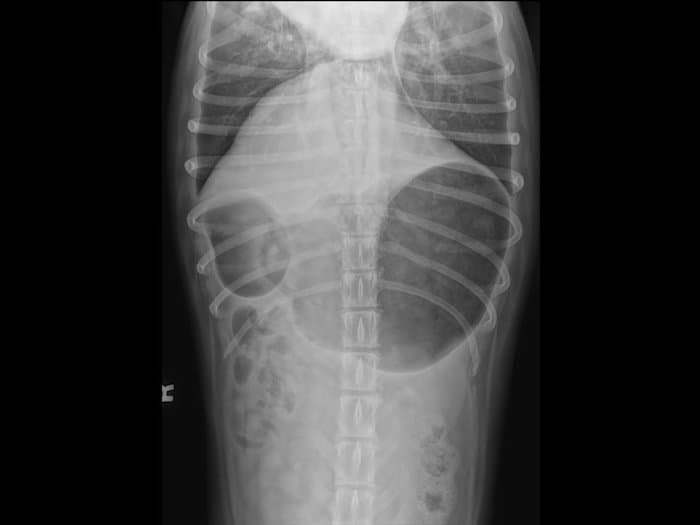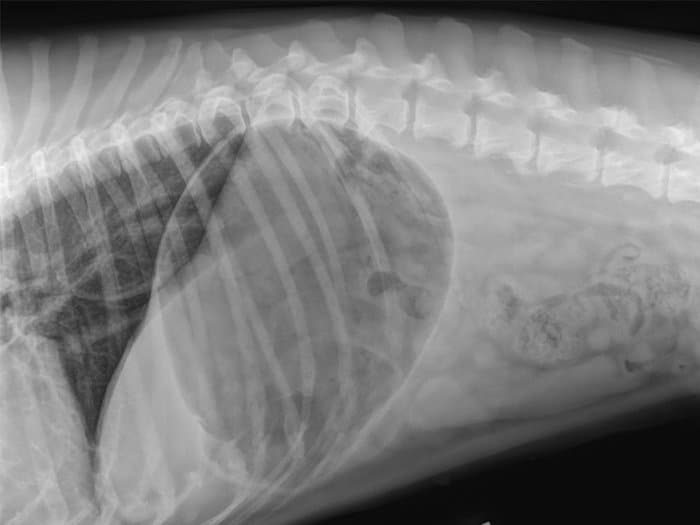Bloat, or gastric dilation, is a medical emergency in which the stomach fills up with gas. The condition can progress to 'gastric dilation and volvulus', in which the large gas-filled stomach twists around so that the entrance and exit are fully blocked. This can be rapidly fatal and urgent veterinary treatment will be needed to save the dog's life. If you suspect your dog may have bloat, call your vet straight away.
What happens in bloat and what are the signs?
In bloat, gas builds up in the stomach. The following animations show the normal dog stomach and how it empties:
Animation of the anatomy of the stomach in the dog:
Animation of normal stomach emptying:
What happens in bloat is that the stomach fills up with gas. It can then twist, meaning that the entrance and exit of the stomach become blocked. This is 'gastric dilation and volvulus' (GDV), as shown in the animation below:
Animation of the mechanism of dilatation and volvulus in the dog:
The symptoms of bloat include drooling, unproductive retching and restlessness. Sometimes, you will be able to see that the abdomen is firm and swollen. Your dog's peathing may become faster or more laboured and eventually, if they do not receive treatment, they will collapse. When the stomach twists in GDV, the blood supply to the stomach and other internal organs can be cut off, meaning these tissues will begin to die if your dog does not receive urgent medical attention.
What are the risk factors for bloat?
Bloat is most likely to occur in large deep-chested dogs such as Great Danes, Weimaraners, St Bernards, Standard Poodles and Dobermann Pinschers. However, it is possible for any dog to be affected. Older animals are at more risk than young dogs.
While the exact cause of bloat is not well understood, reports indicate the condition is more likely to occur after dogs eat a large meal quickly. This means it is generally advised to split the daily food intake rather than feeding one large meal per day. Special bowls that slow down eating can be a good idea for susceptible dogs who tend to eat fast, and if you have more than one dog, it may be worth feeding them separately to reduce any pressure from competition.
It has been suggested that vigorous exercise or excessive drinking after eating increases the risk of bloat. Whether this is the case is not fully known, but restricting vigorous exercise after eating may be a wise precautionary measure.
Dogs with a nervous or anxious temperament are also thought to be at more risk of bloat, so owners of nervous large-peed dogs are advised to try to manage stress as much as possible and keep a close eye out at times of change.
What will my vet do?
If you suspect that your dog is developing bloat, your vet will want to see them as soon as possible. Your vet will examine your dog, and if they suspect that bloat is present, they will take an X-ray. A dilated stomach can easily be seen on an X-ray:
Images of X-rays in a dog with GDV:


Your vet will be able to tell from the X-ray whether the stomach is twisted or not, and this will help them decide how serious the situation is and how best to treat your dog. Other investigations including blood tests and an ECG may also be performed to assess your dog's condition.
As regards treatment, your dog may well be in shock so your vet will give them any drugs necessary and put them on a drip. Depending on whether the stomach has twisted and how much, it may be possible for your vet to relieve the pressure by passing a tube through the mouth and into the stomach. An alternative way of letting the gas escape is by passing a needle through the abdominal wall. Your vet will decide whether either of these strategies are appropriate.
GDV is a surgical emergency and your vet will operate to return the stomach to its normal position as soon as it is safe to do so. During the surgical procedure, they will usually suture the stomach to the abdominal wall (a 'gastropexy') to stop it twisting again. There are various techniques for doing this and one of them is shown here:
Animation of a gastropexy procedure in the dog:
Without a gastropexy surgery, it is very likely that bloat will recur.
Even with treatment, GDV is a very serious condition and studies have found that it is fatal in between 10% and 25% of cases. Early diagnosis and treatment increases the chance of a successful outcome, but dogs with bloat can go downhill very quickly. This means it is very important to call your vet as soon as you suspect that your dog may be showing signs of bloat.
Animations ©Medi-Productions
